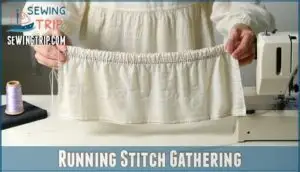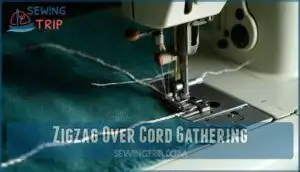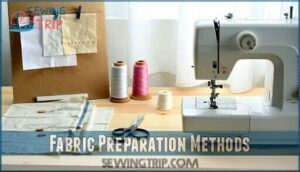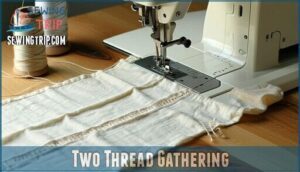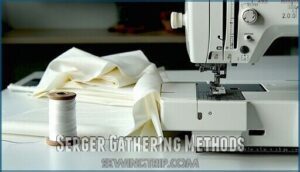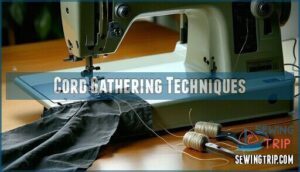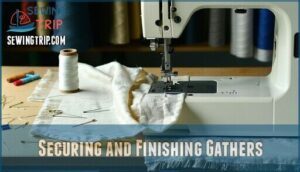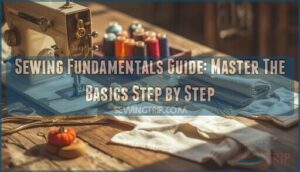This site is supported by our readers. We may earn a commission, at no cost to you, if you purchase through links.

Running stitch gathering gives you precise control for delicate fabrics like silk, while zigzag over cord gathering handles heavy materials effortlessly.
Machine gathering with long stitches works perfectly for lightweight cottons and chiffons.
For stretch fabrics, you’ll need elastic gathering techniques that maintain flexibility.
Shirring creates decorative texture with built-in stretch using elastic thread.
Two-thread and three-thread basting methods offer varying levels of control, while serger gathering speeds up the process for production sewing.
Each technique requires specific thread tension and securing methods to prevent your gathers from loosening—mastering these fundamentals transforms amateur results into professional-looking work.
Table Of Contents
Key Takeaways
- Match your gathering technique to fabric weight – use running stitches for delicate materials like silk, zigzag over cord for heavy fabrics, and elastic methods for stretch materials to prevent thread breakage and achieve professional results.
- Set up your machine correctly – use the longest stitch length (4.0-7.0mm), slightly loosen thread tension, and sew two parallel rows within the seam allowance for stronger, more controllable gathers.
- Master both hand and machine methods – hand gathering gives you precise control for delicate work, while machine gathering with a ruffler foot speeds up production sewing for larger projects.
- Secure your gathers properly – tie off thread tails with double knots, trim seam allowances to reduce bulk, and press gathers away from the seam using gentle steam to create lasting, professional-looking results.
Gathering Stitch Basics
You’ll master seven gathering techniques that transform flat fabric into beautiful, dimensional creations with just a few simple stitches.
Each method works best with specific fabric weights and project requirements, so you’ll choose the right technique every time to ensure the best results with dimensional creations.
Hand Gathering Techniques
Hand gathering gives you ultimate fabric control when machine stitching won’t cut it.
When precision matters most, your hands become the perfect gathering tool
When precision matters most, your hands become the perfect gathering tool.
Use a simple running stitch along your seam allowance, keeping stitches even and thread tension consistent. This technique works brilliantly for delicate fabrics like silk or when you need precise gather placement.
Pull gently to avoid thread breakage, then secure with a slipstitch for professional results.
Machine Gathering Methods
Machine gathering transforms the tedious hand-sewing process into quick, efficient results.
Set your machine to the longest stitch length (4.0-7.0mm) and sew two parallel rows within your seam allowance. A ruffler foot attachment creates automatic gathers as you sew, though it requires practice to master the gather ratio.
Loosen your fabric tension slightly to prevent thread breakage when pulling bobbin threads to achieve your desired fullness. Understanding gathering techniques is essential for achieving professional-looking results in various sewing projects.
Choosing Fabric Type
Fabric selection makes or breaks your gathering project.
Your fabric choice determines whether you’ll achieve stunning results or struggle with every stitch
Different fabric types require specific techniques to achieve smooth, professional results without fighting your material.
- Lightweight fabrics (cotton, silk, chiffon) work beautifully with machine gathering and serger methods
- Medium-weight fabrics (denim, twill) need stronger approaches like cord gathering or multiple parallel stitches
- Stretch fabrics require elastic gathering techniques to maintain their natural flexibility
Types of Gathering Stitches
You’ll encounter several gathering stitch types, each suited to different fabrics and project needs.
Mastering these techniques gives you the flexibility to handle everything from delicate chiffon to sturdy canvas with professional results, allowing you to work with a variety of materials and achieve high-quality outcomes with flexibility.
Running Stitch Gathering
Running stitch gathering creates fabric control through simple, evenly-spaced stitches that you’ll pull to form neat gathers.
This versatile gathering technique works perfectly for lightweight to medium fabrics when you need precise gathering ratios.
Here’s your step-by-step approach:
- Set your stitch length to 4-5mm on machine or customize for hand sewing
- Sew two parallel rows 1/8 to 1/4 inch apart for stronger, more stable gathers
- Adjust thread tension slightly looser to prevent breakage during pulling
- Control sewing speed to maintain consistent running stitch spacing throughout
Leave long thread tails for easy adjustment, then gently pull to achieve your desired gathering ratio.
This basting stitch method offers excellent fabric control.
Understanding the basics of hand stitching techniques is essential for mastering gathering stitches.
Zigzag Over Cord Gathering
When working with stubborn fabrics, zigzag over cord gathering delivers unmatched fabric control.
This gathering technique uses a wide zigzag stitch sewn over strong cord like dental floss, creating reliable gathers without thread breakage.
The cord gathering method excels with heavy materials where standard gathering stitches fail.
| Cord Type | Best For | Gathering Ratio |
|---|---|---|
| Dental floss | Heavy fabrics | 2:1 to 3:1 |
| Crochet thread | Medium weight | 1.5:1 to 2:1 |
| Embroidery floss | Delicate materials | 1:1 to 1.5:1 |
| Strong yarn | Thick textiles | 3:1 to 4:1 |
Set your zigzag stitch wide enough to clear the cord without catching it.
Adjust thread tension slightly looser for smoother stitching.
Pull the cord gently to create even gathers, then secure with straight stitching before removing the cord.
This gathering stitch method prevents frustrating thread snaps on challenging projects.
For ideal results, consider using heavy fabric techniques to achieve professional-looking gathers.
Elastic Gathering Techniques
Elastic gathering techniques create stretchy, comfortable seams perfect for waistbands and cuffs.
You’ll stretch clear elastic while zigzag stitching it directly onto fabric, or use elastic threads in your bobbin for shirring effects.
This gathering technique maintains fabric flexibility, making it ideal for activewear and children’s clothing, and allows for a natural expansion with movement through the stretch stitch, enabling gathered seams to expand naturally with movement.
Shirring Elastic Gathering
Why struggle with multiple gathering rows when shirring elastic creates stretchy, professional results in one go? This shirring stitch transforms lightweight fabrics into fitted, flexible garments without zippers or buttons.
- Wind shirring elastic onto your bobbin without stretching for even tension
- Sew parallel rows 0.5 inches apart using regular thread and longer stretch stitch length
- Hold fabric taut while stitching to prevent bunching under the presser foot
- Steam-set finished gathered seams by hovering iron above fabric to activate elastic contraction
Fabric Preparation Methods
Before you start gathering, you’ll need to prepare your fabric properly to guarantee smooth, even results.
Mark your seam allowances clearly and choose the right thread and tension settings for your specific fabric weight, which is crucial for smooth results, to ensure the best outcome.
Marking Seam Allowance
Before diving into your gathering project, accurate Seam Marking creates the foundation for professional results.
Clear Fabric Notation prevents costly mistakes and guarantees your gathering stitch lands precisely where intended.
| Marking Method | Best For | Tools Needed | Durability | Visibility |
|---|---|---|---|---|
| Chalk pencil | Light fabrics | Fabric chalk | Temporary | High contrast |
| Water-soluble pen | Cotton/linen | Marking pen | Washable | Clear lines |
| Tailor’s tacks | All weights | Thread/needle | Permanent | Subtle marks |
| Notches | Heavy fabrics | Scissors | Permanent | Edge markers |
| Pins | Delicate items | Fine pins | Temporary | Minimal marks |
Using proper seam marking tools is essential for achieving accurate results.
Mark your seam allowance ⅝ inch from the raw edge using Gathering Guides.
These Measurement Tips help position your basting stitch correctly, preventing the dreaded "oops, too close to the edge" moment that ruins hours of work.
Thread Selection and Tension
Beyond choosing the right thread types, you’ll need to master tension control for flawless gathers.
Use high-quality polyester or cotton thread that matches your fabric compatibility. Lower your tension settings slightly—tight thread tension causes breakage when pulling bobbin thread.
Set your stitch length to 4.0-5.0mm for easier gathering. Test bobbin settings on scraps first, verifying your gathering stitch creates smooth, even ruffles without puckering.
For best results, consider matching thread to fabric to guarantee compatibility and durability.
Gathering Techniques and Variations
You’ll find these four gathering techniques offer different advantages depending on your fabric weight and project needs.
Each method creates reliable gathers while giving you varying levels of control over the final result.
Two Thread Gathering
Two-thread gathering transforms fabric like magic, using your machine’s longest stitch setting to create beautiful ruffles. This fundamental gathering technique requires proper bobbin thread tension and parallel stitch spacing for professional results.
- Sew two parallel rows within seam allowance using 4.0mm stitch length
- Pull bobbin threads gently from center outward for even gather distribution
- Secure thread ends with knots to prevent unraveling during construction
This gathering technique works perfectly for lightweight to medium fabrics, making sewing gather projects manageable for beginners. Mastering gathering techniques is essential for achieving professional-looking results in various sewing projects, and it is a key part of creating beautiful and professional sewing projects.
Three Thread Basting
Three thread basting adds precision when standard gathering methods fall short.
You’ll sew a third row of basting stitches alongside your initial two rows, creating superior fabric control for heavy materials or intricate projects.
This gathering technique prevents thread breakage and distributes gathers more evenly than basic methods.
| Aspect | Standard Two Thread | Three Thread Basting |
|---|---|---|
| Stitch Length | 4.0-5.0mm | 5.0-6.0mm |
| Thread Tension | Slightly loose | Normal to loose |
| Gathering Ratio | 1:2 to 1:3 | 1:2.5 to 1:3.5 |
| Fabric Control | Good | Excellent |
| Best For | Light fabrics | Heavy/thick fabrics |
Position your three rows within the seam allowance, spacing them 1/8 inch apart.
Pull all bobbin threads simultaneously for smooth, controlled gathers without puckering.
Serger Gathering Methods
Serger gathering transforms fabric into ruffles with professional speed and precision.
Set your differential feed to 2.0 and adjust serger tension settings for ideal fabric control. This gathering technique creates a consistent 2:1 gathering ratio while finishing raw edges simultaneously.
Use maximum stitch length on lightweight fabrics for best results. A ruffler foot attachment streamlines the process further, making serger gathering methods incredibly efficient for long seams.
Cord Gathering Techniques
Cord gathering conquers heavy fabrics where standard gathering techniques fail.
You’ll zigzag stitch over strong cord—like dental floss or crochet thread—without catching it in stitches. This cord method provides superior fabric control and prevents thread breakage.
Pull the cord to create your desired gather ratio, then secure with knots. The gathering stitch stays intact while you adjust, giving you perfect results every time.
Securing and Finishing Gathers
Once you’ve created your perfect gathers, it’s time to secure them so they won’t disappear on you later.
Proper finishing techniques transform your gathered seam from a temporary arrangement into a polished, professional-looking detail that’ll last through countless wears and washes.
Tying Off Thread Tails
After adjusting your gathers to perfection, you’ll need to lock them in place permanently.
Tie off thread tails with secure knots at both fabric ends, leaving about two-inch tail length for knot security.
Double-knot each gathering stitch to prevent unraveling during wear, as proper thread tension guarantees your securing gathers won’t loosen over time.
Maintaining your carefully created fullness for the finishing gathered seam ahead is crucial, and this is achieved by ensuring that the gathers are securely in place, which in turn relies on the double-knot technique to prevent any potential issues.
Trimming Seam Allowance
Once you’ve secured your gathering stitches, trim the seam allowance to reduce bulk and create cleaner lines.
Cut excess fabric to about 1/4 inch from your seam line, being careful not to snip your gathering stitches.
This seam trimming prevents thick, lumpy seams that can show through your finished garment.
Proper seam cleaning and bulk reduction make pressing easier and improve your project’s professional appearance.
To achieve professional results, mastering gathering techniques is essential for securing gathers and finishing seams, which is crucial for a cleaner finish.
Pressing Gathers for Polish
Once you’ve trimmed your seam allowance, it’s time for the final touch that transforms amateur work into professional results.
Press gathers away from the seam using gentle heat and steam, never directly over the gathered fabric itself.
Here are five essential pressing tips for flawless fabric gathering:
- Use a press cloth to protect delicate fabrics from direct heat damage
- Press seams open first, then gently toward the flat fabric piece
- Apply steam sparingly to avoid flattening your carefully created gathers
- Work from the wrong side to prevent shine on your fabric surface
- Let fabric cool completely before handling to set the pressed seam permanently
This polish technique guarantees your gathering stitch work maintains its intended shape and drape.
Finishing Edges With Zigzag Stitch
After pressing your gathers, protect raw edges with a zigzag stitch to prevent fraying.
Set your machine’s zigzag settings to medium width and adjust stitch length for fabric weight.
This edge finishing technique works better than overlock stitch for gathered seams.
The zigzag creates flexible seam closure that moves with your gathers, unlike rigid whipstitch methods that can restrict fabric movement and cause puckering.
Frequently Asked Questions (FAQs)
What are the different types of gathers in sewing?
Practice makes perfect—you’ll master gathering techniques through hands-on experience.
You can create gathers using machine stitching, hand basting, serger methods, cord zigzagging, elastic insertion, or shirring elastic for different fabric weights and effects.
What are the 4 groups of stitches?
You’ll work with four fundamental stitch groups: straight stitches for construction, zigzag stitches for stretch and finishing, decorative stitches for embellishment, and buttonhole stitches for functional closures and reinforcement.
What are the 7 different types of seams?
Like a tailor’s toolkit, seams are your construction lifelines.
You’ll master plain, French, flat-fell, bound, overlock, welt, and lapped seams.
Each serves different purposes—durability, decoration, or finishing edges perfectly for your sewing projects.
What stitch is best for gathering?
Machine gathering with straight stitches works best—set your longest stitch length and sew two parallel rows within the seam allowance, then gently pull the bobbin threads.
What are the different types of hemming stitches?
Professional tailors use approximately twelve distinct hemming stitches, each serving specific fabric weights and finish requirements.
You’ll master blind hem, catch stitch, and running stitch for invisible finishes, plus overlock and zigzag for stretch fabrics.
What gathering stitch spacing works best for velvet?
For velvet’s luxurious pile, use longer stitch spacing of 6-7mm with loose tension.
Sew two parallel rows within your seam allowance, then gently pull bobbin threads.
This prevents crushing velvet’s delicate fibers while creating beautiful gathers.
How do you gather bias-cut fabric pieces?
Bias-cut fabrics stretch dramatically—up to 40% more than straight grain.
You’ll need gentle handling and shorter stitches to prevent distortion.
Use a walking foot, sew two parallel rows with 0mm stitch length, and gather slowly while supporting the fabric’s natural drape.
Can you gather synthetic leather or vinyl?
You can gather synthetic leather and vinyl, but it’s tricky.
Use cord gathering with zigzag stitches over strong thread instead of traditional methods.
These materials don’t handle needle holes well, so gather sparingly.
Whats the maximum fabric length for gathering?
Consider a wedding dress train – seamstresses typically gather up to 3-4 yards maximum.
You’ll find longer pieces become unwieldy, causing uneven distribution and thread breakage.
For best results, stick to 2-3 yards per gathering section to avoid issues like uneven distribution and thread breakage.
How do you fix uneven gathers?
Redistribute bunched areas by gently nudging fabric along the gathering threads. Remove pins, readjust sections that’re too full or sparse, then re-pin evenly spaced intervals before securing permanently.
Conclusion
Remarkably, many sewers discover their favorite types of gathering stitches by accident—what starts as a mistake often becomes their go-to technique.
You’ve now learned seven essential gathering methods that’ll handle any fabric challenge.
Running stitches work beautifully for delicate materials, while zigzag over cord tackles heavy fabrics effortlessly.
Machine gathering speeds up lightweight projects, and elastic techniques maintain stretch in knits.
Remember to adjust thread tension properly and secure your ends thoroughly.
With practice, you’ll instinctively choose the right technique for each project, creating professional results every time.
- https://en.wikipedia.org/wiki/Gather_(sewing)
- https://fitforartpatterns.com/2023/06/20/gathering-stitches/
- https://www.doinaalexei.com/beginnersewingtutorialblog/what-is-gathering-and-how-to-sew-a-gathered-seam
- https://www.asg.org/sewing-back-to-basics-gathering/
- https://www.threadsmagazine.com/project-guides/learn-to-sew/create-beautiful-evenly-distributed-gathering

